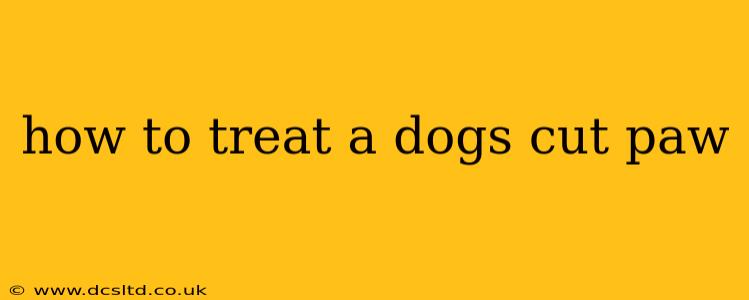A cut paw can be a distressing experience for both you and your furry friend. Knowing how to properly treat the injury is crucial to prevent infection and ensure a speedy recovery. This guide provides a step-by-step approach to caring for your dog's injured paw, covering everything from minor scrapes to more serious wounds.
Assessing the Injury:
Before starting any treatment, carefully assess the severity of the cut. Is it a small scrape, a deeper gash, or something more significant? Look for signs of bleeding, embedded debris, and swelling. If the bleeding is profuse, or if the wound is deep, excessively painful, or shows signs of bone or tendon damage, seek immediate veterinary attention. This is not something you should attempt to treat at home.
Cleaning the Wound:
What is the best way to clean a dog's cut paw? Gentle and thorough cleaning is paramount. Use lukewarm water and a clean cloth or gauze to gently remove any dirt, debris, or foreign objects from the wound. Avoid using harsh soaps or antiseptic solutions, as these can irritate the delicate skin and delay healing. For minor cuts, plain water is often sufficient. If you're unsure, your vet can advise on the best cleaning solution.
Applying a Bandage:
Should I put a bandage on my dog's paw? Bandaging is often necessary, particularly for deeper cuts or wounds that are prone to reopening. Use sterile gauze pads to cover the wound, followed by a soft, clean bandage. Ensure the bandage is snug but not too tight – it shouldn't constrict blood flow. If your dog is particularly active, you may need to use a protective boot or sock over the bandage to prevent it from coming loose. Check the bandage regularly for signs of dampness or excessive tightness.
Monitoring for Infection:
How do I know if my dog's paw is infected? It's crucial to monitor your dog's paw closely for signs of infection. These may include increased swelling, redness extending beyond the initial wound, pus, increased pain, and limping. If you observe any of these symptoms, contact your veterinarian immediately. Antibiotics may be necessary to treat an infected wound.
Pain Management:
How can I help my dog with paw pain? Your dog may experience pain and discomfort from the injury. If the pain is significant, your vet may prescribe pain medication. Never administer human pain medication to your dog without consulting your vet. Some vets may also suggest applying a cold compress (ice wrapped in a cloth) to reduce swelling and pain, but this should be done only under veterinary supervision.
When to See a Vet:
When should I take my dog to the vet for a cut paw? It's crucial to seek veterinary attention if:
- The bleeding is severe or doesn't stop after 10-15 minutes of direct pressure.
- The wound is deep or involves bone or tendon.
- There are signs of infection (swelling, redness, pus).
- Your dog is showing signs of significant pain or discomfort.
- The wound is on a joint, and the dog has difficulty moving.
- The wound doesn't show signs of healing after a few days of home care.
Remember, preventing further injury is key. Keep your dog from licking the wound, as this can introduce bacteria and delay healing. A cone or Elizabethan collar may be necessary for particularly persistent lickers.
This guide provides general information. Always consult your veterinarian for personalized advice and treatment based on your dog's specific injury and needs. Early intervention can make a significant difference in ensuring a successful recovery.
